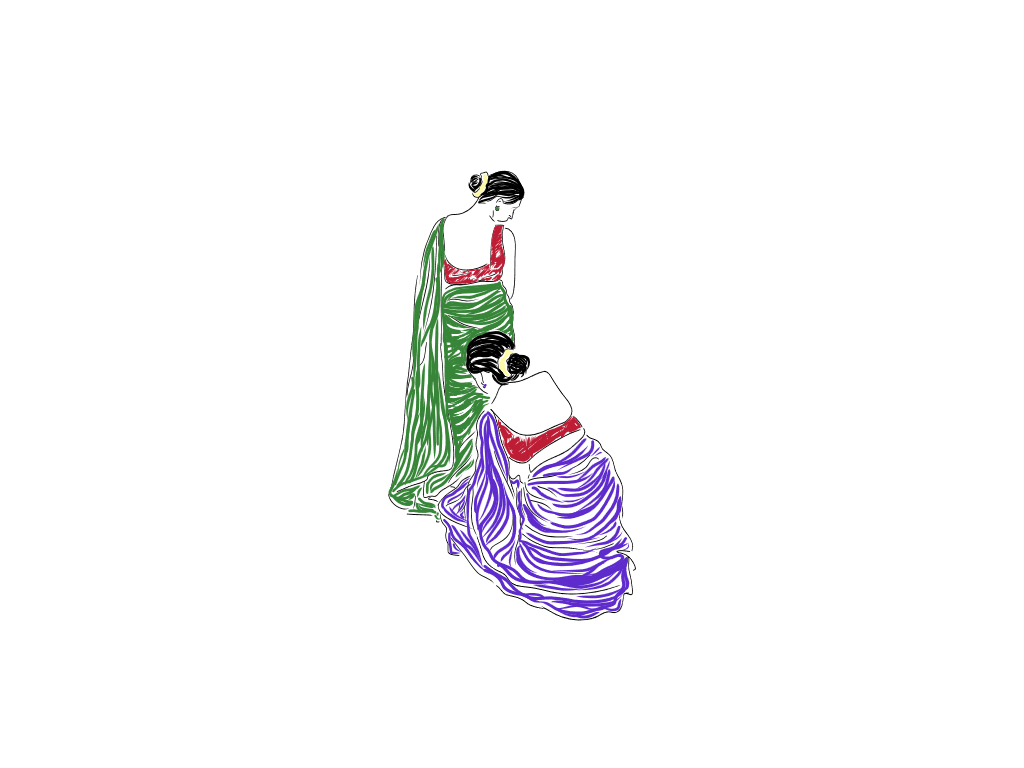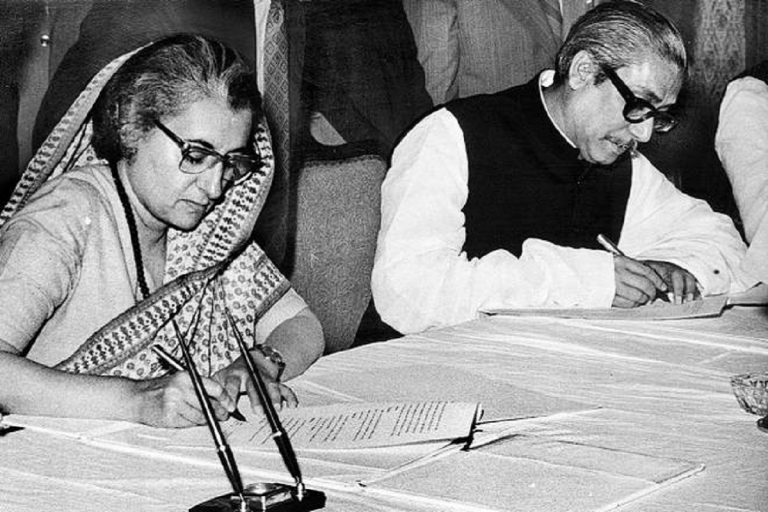Saree: A timeless fabric for all occasions

Aparajita is currently doing her PhD in Visual Arts, Arts and Aesthetics at JNU. She is a trained archaeologist and has participated in exacavations at Rakhigarhi,Haryana and Odhisa. Her main area of interest is study of Ancient Indian history and culture.
The song “Desi Girl” apart from being a wonderful piece of composition, is often remembered for the gorgeous saree Priyanka had worn. The song conveyed the message easily that a desi girl has a talent of sporting a traditional garment like saree in the most creative of ways. One can argue that erstwhile actresses like Madhuri, Sridevi and Raveena had already proven the sensuous charm evoked by the garment. Women in a saree with an exposed midriff have often been an object of male voyeurism. This popular representation was largely a creation of the media that wanted to idealise a particular body type or emphasise particular aspects of female beauty.
On the other hand, our darling saree has also been an undisputed ambassador of India for the outside world. The many forms of fabric woven together with distinct threads and in different patterns is a marker of our diversity. Depictions of women decked in the garment have been carved on pillars and walls of temples across India. The garment is thus, intrinsically associated with Indian culture and tradition.
The garment, over the years, has had multiple facets, the word “Saree” has been an equivalent to grandeur, evoking sensuality and is a source of oriental pride and awe. We can safely conclude that saree has often enjoyed the undisputed laurel of being associated with elegance and beauty. But, at the same time, it transcends the wall and easily transforms itself into being an attire of masses in some parts of India and has also played a distinguished role in our freedom struggle. It was an important tool of revolution, empowerment and resistance. The journey of saree has indeed been a long one, traversing past generations and narrating the tale of human passion.
Saree in pre-Independence India
While tracing the history of saree it is important to understand that for most of Indian history people would cover their bodies with a rectangular-shaped lower and upper garment. In a tropical country like India, this form of dressing was more suitable for agricultural and allied activities. It was gradually, over a period of time that the concept of Saree and lungi emerged.
The garment saree was mostly worn in parts of Bengal, Southern India and Maharashtra. In those states too, distinct types of sarees were worn. In Kerala, the concept of wearing the bodice was based on caste. A married woman from upper caste was to wear a bodice, the women from the middle strata were allowed to cover their breasts with the loose end of a saree, while the women from lower caste had to leave their breasts uncovered.
In colonial Bengal, saree was made of a single cloth and was draped around the body with no garments beneath. This made them look semi clad to a foreigner’s eyes, for whom exposure was considered uncivilized. From the concept of ‘Bhadra Lok’ derived the image of a ‘Bhadra Mahila’. These women belonged to the ‘Bhadra Lok’ genre and were highly educated. As education was made accessible to women, the Bhadra women had to venture out. On the streets, their attire had to reflect their higher status as compared to other women. It was then that saree was used as a medium for distinction. It was the use of blouse which instantly distinguished a Bhadra Mahila, from the rest of the women.
In Maharashtra, the six yards were traditionally worn in a style known as “Navari” which is a nine-yard-long saree draped like a dhoti. In the rural area, the navari is worn till the knees which makes it easier for women to work on the fields. It was the advent of the six-yard variant popularly known as “sahvari” in Marathi which created two different styles of “Navari” and “Sahvari”. The educated Marathi women increasingly opted for the six-yard saree. This even helped create a distinction in the society.
Thus, for most of history saree was a semi clad garment. It was with the help of the Christian missionaries that the concept of shame was introduced following which blouse and petticoat came up. Both concepts were really a British construct. A careful study of modern blouses would reveal that it was in many ways influenced by the torso of the gown. The petticoat brought stiffness to the saree, making the fabric flow and pleats were given a modern form. In the pre-independence period dressing a woman was made a part of the national project. The Parsis followed by Bengali Bhadra samaj women accepted the concept of civilized dressing in the form of the blouse and petticoat. This gained acceptance across other states like in Uttar Pradesh and Maharashtra.
The swadeshi movement further changed the course of the movement where handwoven clothes and indigenous textiles were more rapidly chosen by women. The saree soon became a symbol of Indian women who were at the forefront of the freedom struggle. The homespun Khadi saree got a lot of traction as it was seen as a symbol of independence by the society. Khadi were equated with self-sufficiency and self-reliance. It was a symbol of resistance by the women of India.
Saree and her personality
How a woman chooses to drape a saree gives a lot of cue regarding their personality. Each of the remarkable leaders have had their own way of draping the loved garment. Indira Gandhi’s sarees were equated with exuberance and power. Mamata’s white shows her simplicity combined with elegance. She doesn’t need a coloured garment to give her personality a shape. Sonia Gandhi’s stiff cotton saree depicts her perfection. They are symbols of her demeanour, calmness. But the crease is sharp and perfect.
Pink Saree is an official uniform of the “Gulabi Gang” which was created in Uttar Pradesh to raise voice against the evils of patriarchy. The colour pink is often associated with women or girlishness. The same pink coloured saree coupled with lathi was used to raise their voices against evils in society.
Re-inventing itself
The Saree has continued to keep its relevance in spite of newer fashion trends. The younger generation today is attracted to it and are reinventing the garment in numerous ways. Designers are adding newer dimensions to the garment, experimenting with different looks and shapes. Today, there is a saree for each occasion. For the chic office look linen, cotton sarees are strongly advised, chiffon does the trick for a royal look, Kanjivaram, Maheswari for a family function and netted sarees for a party. The traditional garment has been experimented with, made easy and hassle free to wear. Many designers, while reiterating its relevance have exclaimed how, like the Japanese Kimono even the Indian saree would be able to keep its tradition alive
Newer elements like lightness and weightlessness have been added to saree. People are today teaming it with sneakers, wearing it with t-shirts and jeans. Wearing a saree is evolving too. The myth that women today are increasingly using western wear has been debunked with many of them increasingly moving towards the saree. Newer designs in blouses have come out -some of the most recent introductions are – the backless bikini blouse, tunic blouse, jacket style blouse. The latest is the shirt style blouse adding a jacket to the saree has also become a fashion.
The way of draping the saree has also changed. Today we have trouser sarees, they are teamed with capris and cigar pants. There is even a Bikini saree popularly termed as Sarikini. One of my favourites is the belt which is worn around a saree- most of these are thick leather belts. This feature is helpful as it gives a considerable poise to the waist and also keeps the saree intact. This gives the saree a more formal look, making it look chic. The pallu is also worn around the neck now, which makes it more manageable. The saree is no more considered a traditional attire, reinventing itself according to the needs of the new generation.
Promoting saree
There have been many online programmes which are promoting saree culture in India. 100sareepact is a movement which urges people to wear saree at least 100 days a year. A lot has to be attributed to the ladies who have pushed the cause of saree – be it actresses like Rekha and Vidya Balan who have bought saree to a forefront or Jaya Jaitly who has worked relentlessly to revive the fabric, working more closely with artisans. In her opinion, beyond the fashionista, it is the common Indian woman, who wear it regularly that helps keep the garment alive. While promoting it is all good, over indulgence is not a sane thing. A lot of designers have cried foul against designers today who never made sarees before, but have jumped in to cash in on the trend to make the most of the opportunity. It is at times termed as a pseudo trend. A similar thought is shared by Jaya Jatily according to whom, saree is increasingly becoming an object of fetish in urban areas. Our grandparents, mothers who have donned sarees have done so effortlessly, out of their own free will. There is absolutely no need to make a ritual out of wearing a saree or for that matter any regional garment. People should increasingly gravitate towards wearing a saree, rather than having to be moulded to use it as something to go for on a particular occasion.
Featured Image: PxHere









Informative and interesting reading about Saree, one of the most admired dress . The history and cultural aspect of Saree in different parts of India is beautifully explained
Beautifully written article that covers historical, cultural and contemporary aspects of Saree.
Very informative and crisp.